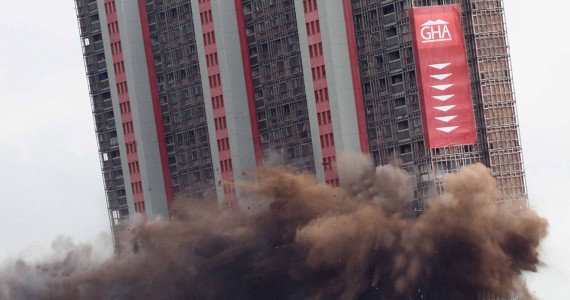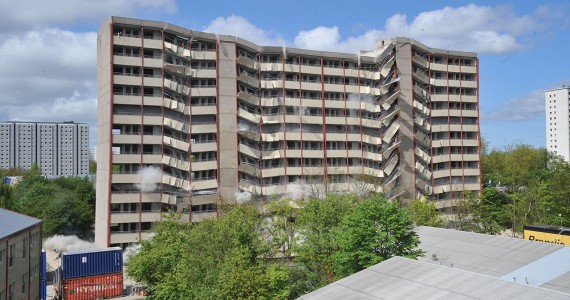Rosyth
Probably the biggest demolition by controlled explosives in the world!
The project is a concrete bunker with the following vital statistics:-
- Total plan area of the structure approx. 9 acres
- Total reinforced concrete 1,000,000 tonnes
- Total concrete roof thickness 7.5 m
- Total perimeter wall thickness 8 m
Number of structural support columns over 3,000 at 1.2 m diameter Built between World War I and World War II in the 1930’s, the bunker was used as a Ministry of Defence Oil Storage Facility, strategically located to the north of Edinburgh on the River Forth on Scotland’s east coast. Following World War I, the remit to Engineers was to design an oil storage facility that was bomb proof.
Their solution was to build a roof with a total thickness of nearly 7.5m, built up in layers of heavily reinforced concrete laid on top of each other.
Each layer was poured to a maximum depth of almost 1m. On top of the 7.5m thick roof, a 600mm cushion of whin dust and a further 400mm of topsoil would give the illusion of a grass field from above.
A forest of over 3,000 1.2 diameter reinforced concrete columns each 12m high, were designed to hold the massive roof structure in place.
The obvious question for the developer was “Why not build on top of it?”. However insurance companies would not warrant any new build on an ageing structure of this type.
With the fate of the structure decided, Safedem formulated a combined approach which would include the use of explosives to break up the structure in pre-determined sections which would then be processed by excavators to separate reinforcement bar from the concrete.
This could only happen following a thorough environmental clean and decontamination of oil residues from within the bunker.
Initial vertical drill holes charged with explosives to form an opening within the roof structure have now successfully been carried out. This initial series of blasts has required the use of over 250kg of explosives.
Safedem experts have taken into account the levels of ground vibration and the air overpressure emanating from the use of explosives, by utilising a delay sequence and initiation system which has reduced vibration and air overpressure readings to nominal levels.




